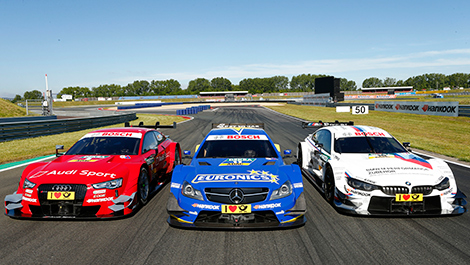Sep
30th
Stay connected Subscribe to our RSS feed
From DTM
DTM and the Japanese Super GT are making big steps forward in their goal to race under one set of technical regulations.
Since the beginning of the 2014 season, the technical regulations - mainly in the chassis and the aero areas - have been identical, in the two series and from 2017, there also will be joint engine regulations: two litres, four cylinders, turbocharged. These are the key data of the new ‘Class One' - how it will be internationally called.
That was agreed upon by DTM rights holder and promoter ITR e.V., the Japanese Super-GT organisers GTA and all the manufacturers involved during a joint meeting, on September 30th in Tokyo.
In addition, the American motor-racing association, IMSA, also plans to announce races according to the new Class-One regulations.
Class One
While the names and specific characteristics of the different race series are supposed to be maintained, the DTM, Super GT and IMSA representatives agreed upon a range of technical details that are to be included into a common set of regulations, in force all over the world, under the name ‘Class One'.
The top priorities: spectacular cars, a high level of safety and a cutback of operation and development costs. While silhouette and looks are similar to the ones of the latest DTM and Super-GT vehicle generations, it was agreed that turbocharged four-cylinder two-litre engines with a horsepower output of some 600bhp will power the cars from 2017.
Moreover, a range of details like test limitations, tire specifications and the use of DRS also were addressed in the meeting of the so-called ‘steering committee' of the three race series. Thanks to these moves, those involved are convinced to be on a good way to being able to contest races in other championships without major modifications being necessary, with a Class One car from 2017.
DTM and the Japanese Super GT are making big steps forward in their goal to race under one set of technical regulations.
Since the beginning of the 2014 season, the technical regulations - mainly in the chassis and the aero areas - have been identical, in the two series and from 2017, there also will be joint engine regulations: two litres, four cylinders, turbocharged. These are the key data of the new ‘Class One' - how it will be internationally called.
That was agreed upon by DTM rights holder and promoter ITR e.V., the Japanese Super-GT organisers GTA and all the manufacturers involved during a joint meeting, on September 30th in Tokyo.
In addition, the American motor-racing association, IMSA, also plans to announce races according to the new Class-One regulations.
 |
| The current DTM cars (Photo: dtm.com) |
Class One
While the names and specific characteristics of the different race series are supposed to be maintained, the DTM, Super GT and IMSA representatives agreed upon a range of technical details that are to be included into a common set of regulations, in force all over the world, under the name ‘Class One'.
The top priorities: spectacular cars, a high level of safety and a cutback of operation and development costs. While silhouette and looks are similar to the ones of the latest DTM and Super-GT vehicle generations, it was agreed that turbocharged four-cylinder two-litre engines with a horsepower output of some 600bhp will power the cars from 2017.
Moreover, a range of details like test limitations, tire specifications and the use of DRS also were addressed in the meeting of the so-called ‘steering committee' of the three race series. Thanks to these moves, those involved are convinced to be on a good way to being able to contest races in other championships without major modifications being necessary, with a Class One car from 2017.
 The latest auto news, reviews, prices, product and vehicle releases.
The latest auto news, reviews, prices, product and vehicle releases.